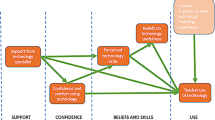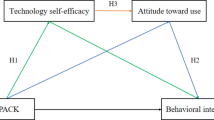Abstract
The current study aims to explore predictors that independently contribute to high school teacher use of technology in general and for different teaching purposes (student-centered and traditional). High school teachers (N = 928) responded to a survey that consisted of measures in several categories: (1) teachers’ background variables, (2) teachers’ pedagogical beliefs, (3) teachers’ attitudes or beliefs towards technology, (4) teachers’ perceived training effectiveness. A series of multilevel models were used to explore the independent effects of these factors on teacher use of technology in general and for different teaching purposes. The results showed that teachers’ technology self-efficacy was a significant predictor of teacher use of technology. More importantly, teachers’ instructional approach, openness towards technology, and perceived teaching training effectiveness were more salient when predicting teacher use technology to support student-centered teaching than when predicting teacher use technology to support traditional teaching. Our findings suggest that teachers’ pedagogical readiness is as important as technological readiness for teachers to integrate technology in teaching to serve more advanced teaching purposes. This study has important implications for organizing professional learning experiences for teachers.
Similar content being viewed by others
References
Afshari, M., Bakar, K. A., Luan, W. S., Samah, B. A., & Fooi, F. S. (2009). Factors affecting teachers’ use of information and communication technology. International Journal of Instruction, 2(1), 77–104.
Aldunate, R., & Nussbaum, M. (2013). Teacher adoption of technology. Computers in Human Behavior, 29(3), 519–524.
Ananiadou, K., & Claro, M. (2009). 21st century skills and competences for new millennium learners in OECD countries.
Anderson, L. W. (Ed.), Krathwohl, D. R. (Ed.), Airasian, P. W., Cruikshank, K. A., Mayer, R. E., Pintrich, P. R., Raths, J., & Wittrock, M. C. (2001). A taxonomy for learning, teaching, and assessing: A revision of Bloom’s Taxonomy of Educational Objectives (Complete edition). New York: Longman.
Baek, Y., Jung, J., & Kim, B. (2008). What makes teachers use technology in the classroom? Exploring the factors affecting facilitation of technology with a Korean sample. Computers & Education, 50(1), 224–234.
Bandura, A. (1989). Regulation of cognitive processes through perceived self-efficacy. Developmental Psychology, 25(5), 729.
Baylor, A. L., & Ritchie, D. (2002). What factors facilitate teacher skill, teacher morale, and perceived student learning in technology-using classrooms?. Computers & Education, 39(4), 395–414.
Berrett, B., Murphy, J., & Sullivan, J. (2012). Administrator insights and reflections: Technology integration in schools. The Qualitative Report, 17(1), 200–221.
Buabeng-Andoh, C. (2012). Factors influencing teachers’ adoption and integration of information and communication technology into teaching: A review of the literature. International Journal of Education and Development using Information and Communication Technology, 8(1), 136.
Bulman, G., & Fairlie, R. W. (2016). Technology and education: Computers, software, and the internet (No. w22237). National Bureau of Economic Research.
Chen, R. J. (2010). Investigating models for preservice teachers’ use of technology to support student-centered learning. Computers & Education, 55(1), 32–42.
Christensen, R., & Knezek, G. (2017). Validating the technology proficiency self-assessment questionnaire for 21st century learning (TPSA C-21). Journal of Digital Learning in Teacher Education, 33(1), 20–31.
Cuban, L. (2001). Oversold and underused: Computers in the classroom. Cambridge, MA: Harvard University Press.
Cuban, L., Kirkpatrick, H., & Peck, C. (2001). High access and low use of technologies in high school classrooms: Explaining an apparent paradox. American Educational Research Journal, 38(4), 813–834.
Davis, F. D. (1989). Perceived usefulness, perceived ease of use, and user acceptance of information technology. MIS Quarterly, 13(3), 319–340.
Davis, F. D., Bagozzi, R. P., & Warshaw, P. R. (1989). User acceptance of computer technology: A comparison of two theoretical models. Management Science, 35(8), 982–1003.
Drent, M., & Meelissen, M. (2008). Which factors obstruct or stimulate teacher educators to use ICT innovatively? Computers & Education, 51(1), 187–199.
Dweck, C. S., Chiu, C. Y., & Hong, Y. Y. (1995). Implicit theories and their role in judgments and reactions: A word from two perspectives. Psychological Inquiry, 6(4), 267–285.
Ertmer, P. A. (1999). Addressing first-and second-order barriers to change: Strategies for technology integration. Educational Technology Research and Development, 47(4), 47–61.
Ertmer, P. A., & Ottenbreit-Leftwich, A. T. (2010). Teacher technology change: How knowledge, confidence, beliefs, and culture intersect. Journal of Research on Technology in Education, 42(3), 255–284.
Ertmer, P. A., Ottenbreit-Leftwich, A. T., Sadik, O., Sendurur, E., & Sendurur, P. (2012). Teacher beliefs and technology integration practices: A critical relationship. Computers & Education, 59(2), 423–435.
Ertmer, P. A., Ottenbreit-Leftwich, A., & Tondeur, J. (2015). Teacher beliefs and uses of technology to support 21st century teaching and learning. In H. R. Fives & M. Gill (Eds.), International handbook of research on teacher beliefs (pp. 403–418). New York: Routledge, Taylor & Francis.
Fu, J. S. (2013). ICT in education: A critical literature review and its implications. International Journal of Education and Development using Information and Communication Technology, 9(1), 112.
Giordano, V. A. (2007). A professional development model to promote Internet integration into p-12 teachers’ practice: A mixed methods study. Computers in the Schools, 24(3–4), 111–123.
Gregorcic, B., Etkina, E., Planinsic, G. (2017). A new way of using the interactive whiteboard in a high school physics classroom: A case study. Research in Science Education. https://doi.org/10.1007/s11165-016-9576-0
Groff, J., & Mouza, C. (2008). A framework for addressing challenges to classroom technology use. AACe Journal, 16(1), 21–46.
Hall, G. E. (2010). Technology’s Achilles heel: Achieving high-quality implementation. Journal of Research on Technology in Education, 42(3), 231–253.
Harper, B., & Milman, N. B. (2016). One-to-one technology in K-12 classrooms: A review of the literature from 2004 through 2014. Journal of Research on Technology in Education, 48(2), 129–142.
Hermans, R., Tondeur, J., van Braak, J., & Valcke, M. (2008). The impact of primary school teachers’ educational beliefs on the classroom use of computers. Computers & Education, 51, 1499–1509.
Hernández-Ramos, P. (2005). If not here, where? Understanding teachers’ use of technology in Silicon Valley schools. Journal of Research on Technology in education, 38(1), 39–64.
Hew, K. F., & Brush, T. (2007). Integrating technology into K-12 teaching and learning: Current knowledge gaps and recommendations for future research. Educational Technology Research and Development, 55(3), 223–252.
Inan, F. A., & Lowther, D. L. (2010). Factors affecting technology integration in K-12 classrooms: A path model. Educational Technology Research and Development, 58(2), 137–154.
International Society for Technology in Education. (2008). Essential conditions: Necessary conditions to effectively leverage technology for learning. Eugene, OR: Author. Retrieved from http://www.iste.org/standards/nets-for-teachers.aspx.
International Society for Technology in Education. (2009). ISTE standards: Administrators. Retrieved September 2017 from: http://www.iste.org/standards/iste-standards/standards-for-administrators.
Kay, R. H. (2006). Evaluating strategies used to incorporate technology into preservice education: A review of the literature. Journal of Research on Technology in Education, 38(4), 383–408.
Kim, C., Kim, M. K., Lee, C., Spector, J. M., & DeMeester, K. (2013). Teacher beliefs and technology integration. Teaching and Teacher Education, 29, 76–85.
Knezek, G., & Christensen, R. (2016). Extending the will, skill, tool model of technology integration: adding pedagogy as a new model construct. Journal of Computing in Higher Education, 28(3), 307–325.
Koehler, M. J., & Mishra, P. (2009). What is technological pedagogical content knowledge. Contemporary issues in technology and teacher education, 9(1), 60–70.
Levin, T., & Wadmany, R. (2008). Teachers’ views on factors affecting effective integration of information technology in the classroom: Developmental scenery. Journal of Technology and Teacher Education, 16(2), 233.
Minnesota Department of Education. (2014). Technology—Instructional Practices Survey for Minnesota Teachers. Retrieved December 2017 from https://education.state.mn.us/mdesurvey/index.php/16773/langen.
Miranda, H. P., & Russell, M. (2012). Understanding factors associated with teacher-directed student use of technology in elementary classrooms: A structural equation modeling approach. British Journal of Educational Technology, 43(4), 652–666.
Mumtaz, S. (2000). Factors affecting teachers’ use of information and communications technology: A review of the literature. Journal of Information Technology for Teacher Education, 9(3), 319–342.
Niederhauser, D. S., & Stoddart, T. (2001). Teachers’ instructional perspectives and use of educational software. Teaching and Teacher Education, 17(1), 15–31.
O’Bannon, B. W., & Thomas, K. (2014). Teacher perceptions of using mobile phones in the classroom: Age matters! Computers & Education, 74, 15–25.
Overbay, A., Patterson, A. S., Vasu, E. S., & Grable, L. L. (2010). Constructivism and technology use: Findings from the IMPACTing leadership project. Educational Media International, 47(2), 103–120.
P21 Partnership for 21st Century Learning. (2009). Framework for 21st Century Learning. Retrieved December 2017 from http://www.p21.org/about-us/p21-framework.
Palak, D., & Walls, R. T. (2009). Teachers’ beliefs and technology practices: A mixed-methods approach. Journal of Research on Technology in Education, 41(4), 417–441.
Petko, D. (2012). Teachers’ pedagogical beliefs and their use of digital media in classrooms: Sharpening the focus of the ‘will, skill, tool’model and integrating teachers’ constructivist orientations. Computers & Education, 58(4), 1351–1359.
Rodríguez, P., Nussbaum, M., & Dombrovskaia, L. (2012). ICT for education: a conceptual framework for the sustainable adoption of technology-enhanced learning environments in schools. Technology, Pedagogy and Education, 21(3), 291–315.
Sandholtz, J. H., & Reilly, B. (2004). Teachers, not technicians: Rethinking technical expectations for teachers. Teachers College Record, 106(3), 487–512.
SAS Institute. (2004). Statistical analysis system 7.5. Cary, NC: Author.
Scherer, R., Siddiq, F., & Teo, T. (2015). Becoming more specific: Measuring and modeling teachers' perceived usefulness of ICT in the context of teaching and learning. Computers & Education, 88, 202–214.
Spector, J. M. (2010). Learning and instruction in the digital age. In Learning and instruction in the digital age (pp. 375–379). Boston: Springer.
Tondeur, J., Hermans, R., van Braak, J., & Valcke, M. (2008). Exploring the link between teachers’ educational belief profiles and different types of computer use in the classroom. Computers in Human Behavior, 24(6), 2541–2553.
Tondeur, J., van Braak, J., Ertmer, P. A., & Ottenbreit-Leftwich, A. (2017). Understanding the relationship between teachers’ pedagogical beliefs and technology use in education: A systematic review of qualitative evidence. Educational Technology Research and Development, 65(3), 555–575.
U. S. Department of Education, Office of Educational Technology. (2010). Transforming American Education: Learning powered by technology. National Educational Technology Plan, 2010. Retrieved September 8, 2017, from https://www.ed.gov/sites/default/files/netp2010.pdf,
Vanderlinde, R., Aesaert, K., & Van Braak, J. (2014). Institutionalised ICT use in primary education: A multilevel analysis. Computers & Education, 72, 1–10.
Vannatta, R. A., & Nancy, F. (2004). Teacher dispositions as predictors of classroom technology use. Journal of Research on Technology in Education, 36(3), 253–271.
Voogt, J., Fisser, P., Pareja Roblin, N., Tondeur, J., & van Braak, J. (2013). Technological pedagogical content knowledge—A review of the literature. Journal of Computer Assisted learning, 29, 109–121.
Voogt, J., & Knezek, G. (2008). International handbook of information technology in primary and secondary education. New York: Springer.
Windschitl, M., & Sahl, K. (2002). Tracing teachers’ use of technology in a laptop computer school: The interplay of teacher beliefs, social dynamics, and institutional culture. American Educational Research Journal, 39(1), 165–205.
Wong, E. M., & Li, S. C. (2008). Framing ICT implementation in a context of educational change: A multilevel analysis. School Effectiveness and School Improvement, 19(1), 99–120.
Wozney, L., Venkatesh, V., & Abrami, P. C. (2006). Implementing computer technologies: Teachers’ perceptions and practices. Journal of Technology and Teacher Education, 14(1), 173.
Author information
Authors and Affiliations
Corresponding author
Rights and permissions
About this article
Cite this article
Li, Y., Garza, V., Keicher, A. et al. Predicting High School Teacher Use of Technology: Pedagogical Beliefs, Technological Beliefs and Attitudes, and Teacher Training. Tech Know Learn 24, 501–518 (2019). https://doi.org/10.1007/s10758-018-9355-2
Published:
Issue Date:
DOI: https://doi.org/10.1007/s10758-018-9355-2




